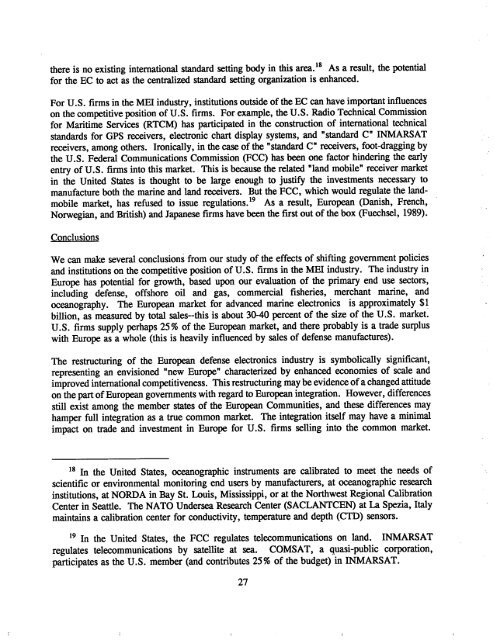WHOI-90-52
WHOI-90-52
WHOI-90-52
You also want an ePaper? Increase the reach of your titles
YUMPU automatically turns print PDFs into web optimized ePapers that Google loves.
there is no existing international stadad setting boy in this area. is As a result, the potential<br />
for the EC to act as the centrize stadad setting organiztion is enhance.<br />
For U. S. firms in the MEI industr, institutions outside of the EC ca have importt influences<br />
on the competitive position of U.S. firms. For example, the U.S. Radio Technica Commission<br />
for Martime Services (RTCM) has parcipate in the constrction of international tehnica<br />
stadards for GPS recivers, electronic char display systems, and "stadard C" INMARSAT<br />
recivers, among others. Ironicaly, in the case of the "stadad C" recivers, foot-dragging by<br />
the U.S. Federa Communications Commission (FCC) has ben one factor hindering the ealy<br />
entr of U.S. firms into this market. This is beuse the relate "land mobile" receiver market<br />
in the United States is thought to be large enough to justify the investments necssa to<br />
manufacture both the marne and land recivers. But the FCC, which would regulate the land-<br />
mobile market, has refuse to issue regulations.<br />
19 As a result, Europe (Danish, French,<br />
Norwegian, and-British) and Japanese fims have ben the fist out of the box (Fuechsel, 1989).<br />
Conclusions<br />
We ca make several conclusions from our study of the effects of shifting government policies<br />
and institutions on the competitive position of<br />
U.S. firms in the MEI industr. The industr in<br />
Europe has potential for growth, base upon our evaluation of the primar end use setors,<br />
including defense, offshore oil and gas, commercial fisheries, merchant marne, and<br />
ocography. The Europe market for advance marne electronics is approximately $1<br />
bilion, as measured by tota saes--this is about 30-40 percent of the size of the U.S. market.<br />
U.S. firms supply perhaps 25% of the Europe market, and there probably is a trade surplus<br />
with Europe as a whole (ths is heavily influenced by saes of defense manufactures).<br />
The restrcturing of the Europe defense electronics industr is symbolically significat,<br />
representing an envisioned "new Europe" charcterize by enhance ecnomies of sce and<br />
improved international competitiveness. This restrcturing may be evidence of a changed attitude<br />
on the par of Europe governments with regard to Europe integration. However, differences<br />
still exist among the member states of the Europe Communities, and these differences may<br />
hamper full integration as a tre common market. The integration itself may have a minimal<br />
impact on trde and investment in Europe for U.S. firms sellng into the common market.<br />
is In the United States, ocographic instrments are caibrated to meet the nees of<br />
scientific or environmenta monitoring end users by manufacturers, at ocographic resech<br />
institutions, at NORDA in Bay St. Louis, Mississippi, or at the Nortwest Regional Calibration<br />
Center in Seattle. The NATO Underse Resech Center (SACLANTCEN) at La Spezia, Itay<br />
maintans a caibration center for conductivity, temperature and depth (CTD) sensors.<br />
19 In the United States, the FCC regulates telecmmunications on land. INMARSA T<br />
regulates telecmmunications by satellte at se. COMSA T, a quasi-public corpration,<br />
paricipates as the U.S. member (and contrbutes 25% of the budget) in INARSAT.<br />
27
















